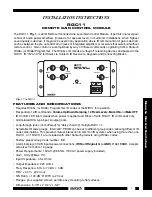
YCCS TEC2603-4 BACnet® MS/TP Networked Multi-Stage Thermostat Controllers Installation Instructions
13
676292-YIM-A-0111
YCCS System Communication Problems
Several factors may influence the behavior of the
System Communication Bus. In addition, certain
problems can affect the Bus in multiple ways and have
multiple symptoms, which makes the exact diagnosis
difficult. For example, duplicate addresses on the Bus
can degrade performance, make the device go offline,
or stop communication completely.
Incomplete Address
The TEC2603-4 Thermostat Controller must have the
address set between 42–65 on the System
Communication Bus; other settings prevent the
thermostat controller from communicating on the
System Communication Bus.
Duplicate Addresses
Two or more devices on a communication Bus cannot
have the same address. For example, two thermostat
controllers cannot both have an address of 42. If two
devices on the same Bus have the same address,
performance can degrade or serious communication
problems may occur. These problems include the
devices not coming online and all communication
stopping completely. Take care when adding or
changing devices that addresses are not duplicated.
Check for duplicate addresses, in the following ways,
depending on the severity of the situation:
•
If the Bus performance is degraded, check the
address settings at the devices with unreliable
communications.
•
If a specific device is not communicating, remove
the device with communication problems and
check if the device address remains online at the
System Manager.
•
If the Bus communication problems are severe,
and no communication is present, or you cannot
determine where communication is unreliable,
partition (disconnect and isolate a portion of the
system Bus for testing purposes) and test the Bus
portion connected to the System Manager.
Correcting Physical Communication Bus Problems
The communication bus is subject to a number of
physical factors that can affect performance. Consider
the following list of common physical problems that
affect the communications bus:
•
Check status LED to verify power at the controller
•
Check wires
-
Verify wire is 22 AWG (0.6 mm) 3-conductor,
twisted, shielded cable.
-
Verify shield is continuous and hard-grounded
at one end.
•
Check wiring
-
Check for and eliminate T-Taps (wire
configurations that create a T shape) and star
configurations.
-
Ensure bus is wired in daisy-chain fashion.
-
Verify that appropriate devices have three
wires entering and exiting each terminal
(devices at the ends of the trunk do not have
this wiring).
•
Check EOL switch settings
-
Verify the System Bus EOL switch on the
System Manager is set to ON and the System
Manager is located at the end of the zone bus
trunk.
-
Verify that only the EOL switch at the end of
the system bus is set to ON and all other
system bus EOL switches are set to OFF.
•
Check connections, polarity, and lengths
-
Verify communications loops are less than
approximately 304 m (1,000 ft) total in length.
-
If you are using one transformer to power
multiple devices, verify the device 24 VAC
power connection follows the polarity of the
common and 24 V terminations.
•
Check for opens and shorts
•
Check terminations
•
Check for sources of interference
Table 3: Status LEDs
LED
Description
Green
The controller is receiving power from the
24 VAC power supply; alarms are not present.
Red
The controller is receiving power from the
24 VAC power supply; alarms are present.
Off
Controller is not receiving 24 VAC power or the
controller is in startup mode.


































